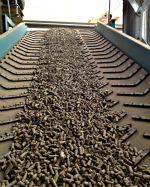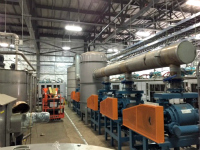The Northeast region of the United States (from the Ohio River to the New England coast) has the natural, social, and technological resources needed to help create a sustainable, rural renaissance by using biomass to create biofuels, biopower, and advanced bioproducts. The Northeast Woody/Warm-Season Biomass Consortium (NEWBio) believes that the path to this vision is through collaboration with commercial innovators along various points of the bioeconomy supply chain. NEWBio’s commercial collaborators, biomass-based business ventures, are laying the groundwork for new, sustainable, and lasting markets that will create jobs, supply energy, and protect the environment in the region.
Feedstock Grower and Supplier Collaborators
Ernst Conservation Seeds

Meadville, PA. Growing switchgrass as a component of its native seed mixes. Much of the harvest from Ernst’s several thousand switchgrass acres is now pelletized at the company’s processing facility. The pelletized grass has reached a number of markets, but is primarily used as a bio-based absorbent material that handles drill cuttings during oil and gas drilling operations. Ernst is already established in the biomass supply chain both as a feedstock producer and processor, employing 90+ people in the region. ernstseed.com
Aloterra

The Woodlands, TX. Aloterra manufactures sustainable products at lower cost and at the same or better performance using non-food crops grown on idle and marginal land. Aloterra achieves this by developing vertically integrated biomass projects utilizing farmer relationships, extensive miscanthus rhizome supplies and expertise in miscanthus agronomy, logistics, manufacturing, and commodity markets. Aloterra believes it is critical to have a stable, consistent, and sustainable biomass supply system that only dedicated perennial crops can provide. Using a reference to the well-known petroleum industry, major investments in refineries are not made until a long-term oil supply is secured and all logistics are known regarding the delivery of this supply to the refinery. aloterrallc.com
Celtic Energy Farm

Maspeth, NY. Celtic Energy Farm is currently cultivating 1,100 acres of willow to complement other sources of renewable biomass being used by ReEnergy Holdings in northern NYto generate renewable power and heat. As supply increases, Celtic Energy Farm believes that innovative willow-to-fuel technologies will continue to develop. Their willow farm is situated where no other sustainable food crops are grown, so its existence does not impact the food chain. Likewise, their willow is grown from natural processes with limited additions of fertilizers and other growth promoters that have their own energy costs. Celtic Energy Farm is dedicated to the development of willow as a low impact, readily available renewable energy source. celticenergyfarm.com
Double A Willow

Fredonia, NY. Driven by concerns about global warming, rural development, and energy security, Double A Vineyards, through its subsidiary Double A Willow, has taken the lead in the large-scale commercialization of shrub willow and other commercial uses. Chosen in 2004 by SUNY-ESF (which has provided three decades of research into the development of shrub willow) as the only licensed commercial nursery to grow and distribute their patented high yielding and fast growing varieties, Double A Willow has developed a large nursery capable of providing planting material for growers across North America. These cuttings will be used primarily to provide fuel supplies for wood and co-firing power plants, and for combined heat and power projects, but are also used for bioremediation projects, living snow fences, streambank stabilization, riparian buffers, living screens, and other landscape projects. As technology improves, willow may be used as a source fuel for large-scale biofuel projects. doubleawillow.com
Logistics Collaborators
CNH America

CNH America is the parent company of New Holland. Since 1895, New Holland has been committed to providing solutions that improve farming efficiency and productivity by using accessible technology. In 2006 the Clean Energy Leader® strategy was launched for the active promotion of renewable fuels, emissions reduction systems and sustainable agricultural technology. Since 2008, CNH has collaborated with SUNY-ESF, Greenwood Resources, and others to design, test, and improve a short-rotation woody crops cutting header (130-FB) for use in shrub willow, hybrid poplar and similar woody plant coppice systems for bioenergy production. The cutting header can be used with all CNH FR 9000 series forage harvesters as well as the new FR Forage Cruiser series, with limited modifications to the forage harvester. The 130-FB cutting header is now commercially available at CNH dealerships, and is being used to harvest commercial shrub willow crops grown in the northeast as part of NEWBio’s equipment access program. cnhindustrial.com
Conversion and Biofuel Market Collaborators
Terra Green Energy
McKean County, PA. Terra Green Energy LLC, has built a torrefaction demonstration facility to show how the process can work for commercial production of a biomass product that could successfully co-fire coal-fired power plants. Torrefaction is a relatively simple way to generate large amounts of renewable energy from biomass. A torrefied woody biomass product stores, travels, and functions much like coal, and can be burned in existing power plants. Therefore it has significant market potential as a renewable fuel to co-fire in pulverized-coal electrical generation plants, said Tom Causer, president and chief operating officer of Terra Green, a renewable fuels technology development company. Co-firing is fast, low-cost, and can use a lot of renewable energy. terragreenenergy.com

Greene Team Pellet Fuel Company, LLC
Greene Team Pellet Fuel was founded with the goal of producing clean, renewable energy and reducing dependence on fossil fuels. Its production facility is located in Green County, PA, at the site of the old Robena Mine. The Robena Mine was built in the years of WWII, and was the largest, most modern coal mine of its time. In the wave of the renewable energy era, Green Team has converted Robena from fossil fuel mining to renewable biofuel production by using sawdust from regional lumber production and other biomass materials as feedstocks to produce wood pellets for renewable heat. greeneteampellets.com
ReEnergy Holding LLC

Latham, NY. ReEnergy is an integrated waste fuel/biomass renewable energy company that operates six energy generation facilities and three recycling facilities in the Northeast. ReEnergy’s recycling facilities collect, process, and recycle items, including biomass, for use as fuel. In some instances this fuel is used to generate power. The biomass material they use can come from many sources, but typically includes forest residues, mill residues, green wood , and wood recovered from urban uses or construction and demolition material.
ReEnergy also has contracted with willow crop producers in northern New York to purchase all willow biomass produced on more than 1,100 acres of plantings for an eleven-year period. ReEnergy has hands in both sides of the waste-to-energy process: its recycling facilities are creating biomass fuel that can be used at facilities such as their renewable energy facilities. Their renewable energy facilities are using biomass fuel to generate electricity for the communities they serve. reenergyholdings.com
Renmatix

King of Prussia, PA. Renmatix has introduced game-changing technology that enables the wide-scale transition from fossil-fuel-based products to bio-based chemicals and fuels. Renmatix’s proprietary Plantrose™ Process pioneers the use of supercritical hydrolysis to break down non-food biomass quickly, using no significant consumables. The resulting Plantro™ sugars serve as the affordable intermediaries that our industry-leading partners require to develop tomorrow’s clean alternatives to today’s conventional fossil-fuel-based products. Renmatix provides a path from cellulose to sugar.
Renmatix purchased the manufacturing facility of Mascoma Corp., another NewBio commercial collaborator. This new feedstock processing facility opened in 2015 as the third U.S. location for Renmatix, and is dedicated to the first step in converting different types of biomass to cellulosic sugar, using proprietary Plantrose® process conditions. renmatix.com
Delta
 Delta Air Lines is partnering with the Carbon War Room, a nonprofit organization founded by Sir Richard Branson, in an effort to accelerate low-carbon jet fuel production worldwide.
Delta Air Lines is partnering with the Carbon War Room, a nonprofit organization founded by Sir Richard Branson, in an effort to accelerate low-carbon jet fuel production worldwide.
The organizations, which have kept a low profile on the specifics of the partnership, agreed that “the development of a secure, sustainable, renewable fuels supply will strengthen the airline industry’s access to high-quality jet fuel, reduce price volatility and the industry’s overall carbon footprint and meet the needs of increasingly climate-conscious customers. Additionally, access to a competitively-priced renewable jet fuel will be advantageous in meeting future regulatory requirements to reduce emissions from the burning of petroleum-based jet fuel.” (Delta Signs with Carbon War Room to Advance Renewable Jet Fuel, Biofuels Digest, 2014.) www.delta.com
 The Northeast Woody/Warm-season Biomass Consortium – NEWBio is supported by the Agriculture and Food Research Initiative. This material is based upon work that is supported by the National Institute of Food and Agriculture, U.S. Department of Agriculture, under award number 2012-68005-19703.
The Northeast Woody/Warm-season Biomass Consortium – NEWBio is supported by the Agriculture and Food Research Initiative. This material is based upon work that is supported by the National Institute of Food and Agriculture, U.S. Department of Agriculture, under award number 2012-68005-19703.
Led by Penn State University, NEWBio includes partners from Cornell University, SUNY College of Environmental Science and Forestry, West Virginia University, Delaware State University, Ohio State University, Rutgers University,  USDA’s Eastern Regional Research Center, and DOE’s Oak Ridge National Laboratory and Idaho National Laboratory.
USDA’s Eastern Regional Research Center, and DOE’s Oak Ridge National Laboratory and Idaho National Laboratory.

